You are viewing 1 of your 1 free articles
Wide players and shape
This session is about wide players making quick, dynamic, well-timed runs, so as to create goalscoring opportunities. It’s important to practise this because, in the modern era, there are many different systems of play, and in all of these wide players are asked and expected to pose a strong goalscoring threat when linking with strikers. This can be the difference in key moments in any game.
| Area | Up to full pitch |
| Equipment | Balls, cones (or poles), goals mannequins |
| No. of Players | Up to 22 (11v11) |
| Session Time |
Warm-up 10mins, timed runs with a finish 20mins, diamond pitch 35mins, game 20mins |
This session is about wide players making quick, dynamic, well-timed runs, so as to create goalscoring opportunities.
It’s important to practise this because, in the modern era, there are many different systems of play, and in all of these wide players are asked and expected to pose a strong goalscoring threat when linking with strikers. This can be the difference in key moments in any game.
Players must always be asking themselves if they can get on the ball, and if they can make a run that leads to a goalscoring chance.
What do I get the players to do?
Two-touch warm-up
We set up as shown in the diagram, with a two-touch passing warm-up. Players get used to laying a good pass then sprinting into another position – in this instance, by running through poles to the right. This lasts for 10 minutes and can involve anything between 12 and 16 players. The speed of passing and movement should get progressively quicker. The warm-up is progressed by the coach signaling a change of direction. We’ll also advance this by making it one-touch.
1
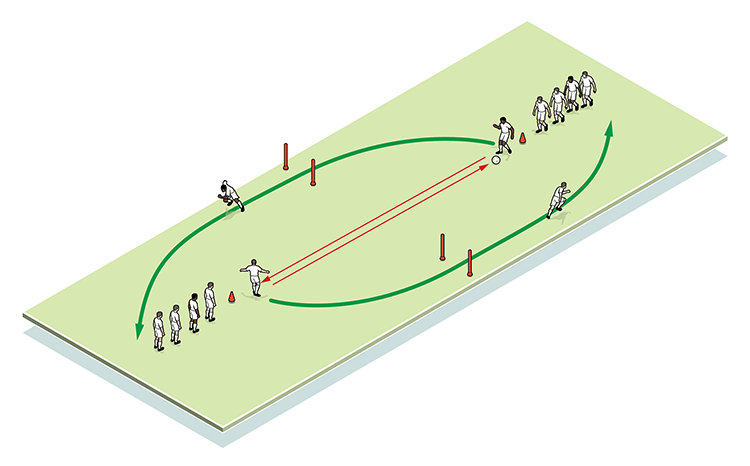
Timed runs with a finish
Next, we set up in lines - 12 to 16 players on a half-pitch with mannequins, as shown. Starting with the player at the front of one of the two middle lines, the ball is passed out to the edge, then back inside. The start player now passes past the central mannequin on that side. The wide player makes a well timed run inside the wide mannequin, takes the ball on and finishes. At the end of the move, players join the back of the line to the right.
The session can be progressed by moving mannequins up the pitch, therefore requiring lofted passes and longer, well-timed runs.
The key coaching points here are well-weighted passes, the speed of runs, staying onside, one- or two-touch finishing, alertness to rebounds and a good overall tempo.
2
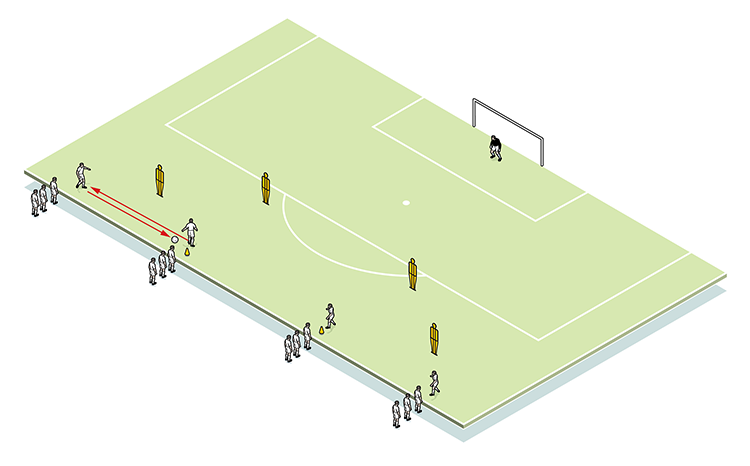
3
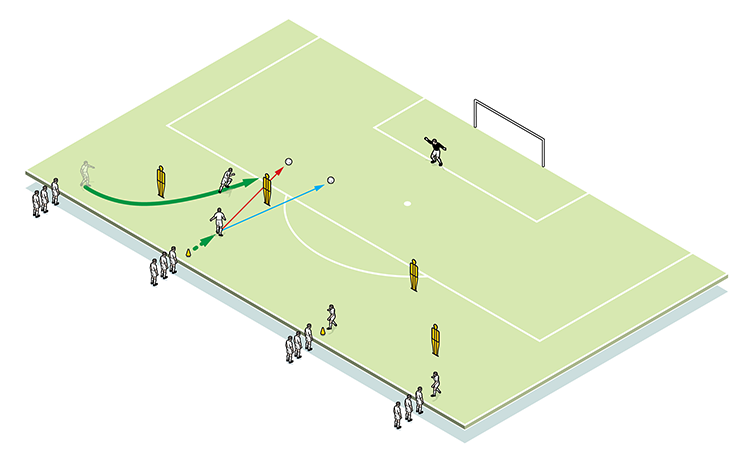
Diamond pitch
The next stage is 8v8, where using a diamond pitch (the space between the penalty areas with the corners removed) eliminates the idea of having a winger. This part is more game related, with all moves built from the keeper. All wide players must link with the forwards.
What we’re encouraging here is wide players coming off the line, inside full-backs and centre-backs. So, within that, we practise movement to receive the ball, interchanging of positions, combination play, ‘give and go’s, support and a variety of penetrating passes. And a good end product is essential.
4a
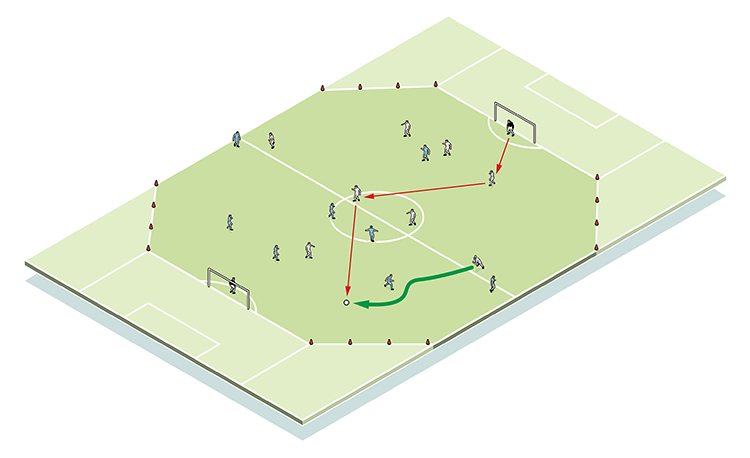
4b
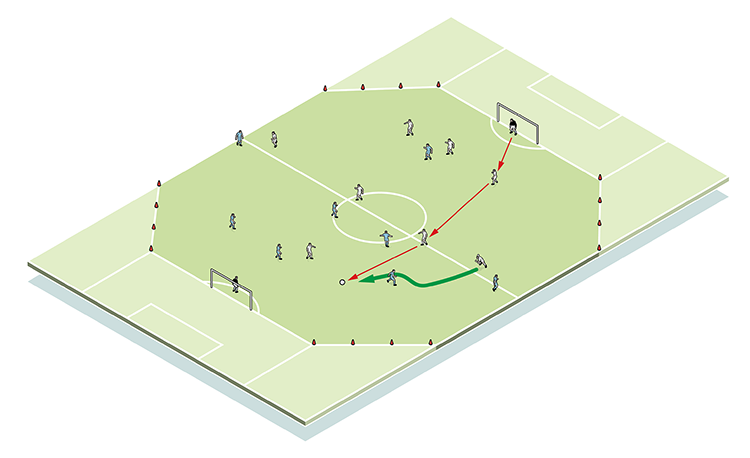
4c
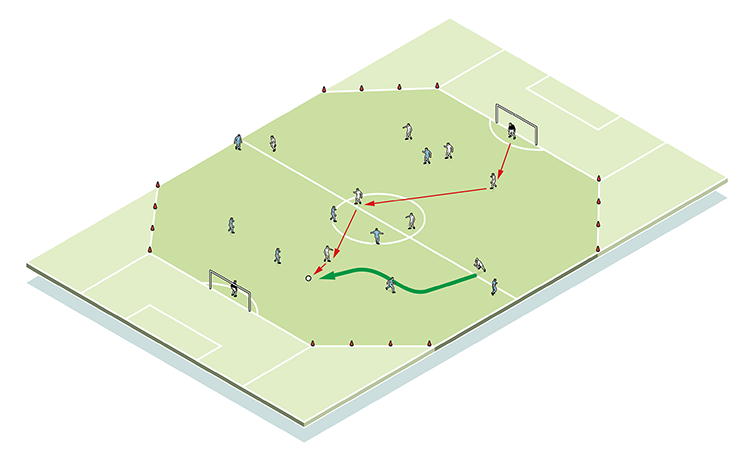
Related Files
Editor's Picks
Intensive boxes drill with goals
Penetrating the final third
Creating and finishing
My philosophy
Pressing initiation
Compact team movement
Defensive organisation
Back three tactics
Counter-pressing as an offensive weapon
Coaches' Testimonials

Alan Pardew

Arsène Wenger

Brendan Rodgers

Carlos Carvalhal

José Mourinho

Jürgen Klopp

Pep Guardiola

Roy Hodgson

Sir Alex Ferguson

Steven Gerrard
Coaches' Testimonials

Gerald Kearney, Downtown Las Vegas Soccer Club

Paul Butler, Florida, USA

Rick Shields, Springboro, USA

Tony Green, Pierrefonds Titans, Quebec, Canada
Join the world's leading coaches and managers and discover for yourself one of the best kept secrets in coaching. No other training tool on the planet is written or read by the calibre of names you’ll find in Elite Soccer.
In a recent survey 92% of subscribers said Elite Soccer makes them more confident, 89% said it makes them a more effective coach and 91% said it makes them more inspired.
Get Monthly Inspiration
All the latest techniques and approaches
Since 2010 Elite Soccer has given subscribers exclusive insight into the training ground practices of the world’s best coaches. Published in partnership with the League Managers Association we have unparalleled access to the leading lights in the English leagues, as well as a host of international managers.
Elite Soccer exclusively features sessions written by the coaches themselves. There are no observed sessions and no sessions “in the style of”, just first-hand advice delivered direct to you from the coach.








